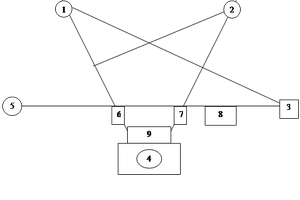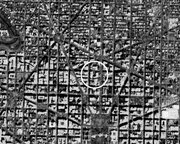Geomachy
From Plastic Tub
|
geomachy nv. 1. An occlusion of blood, exemplified in this instance by a clarity of geographical focus; the associationalist's sleep-shirt. 2. A dirigible for which tickets are always available and upon which only certain names are inscribed. 3. Synonymous with the Pooban geomancy. 4. The poesy of forecasting events or gaining of supernatural information through intellectual collision with the autotelic architecture of vapor; most generally, this applies to natural or geological structures, but it is increasingly being applied to the Associationalist appraisal of human structures, sculpture and related hand-works. [edit] ExtrapolationThe D.C. Pentagram is a configuration of streets in Washington, D.C., which surrounds and encompasses a surprising large number of Freemasonic points of reference as well as the White House. Conspiracy theories abound with claims that this is evidence of some sort of conspiracy wherein Freemasonic/Satanic forces dominate U.S. Government. The general idea is that the city design displays an intermeshing of Satanic and Freemasonic imagery and symbology which engulfs the seat of governmental power, and thus serves to either symbolize or actually magically empower the Freemasonic/Satanic control of the United States. While it’s true that there is, in fact, a very visible (if incomplete) pentagram formed in the D.C. street plan, there are at least two major flaws with this theory. First, although Freemasons and
In this wider historical context, the pentagram is better viewed as symbol or magical invocation of capturing or containment. In this sense, the conspiracies may be correct –- perhaps the pentagram is meant to serve as a symbolic means of a controlling ensnarement. But what the conspiracies fail to note is that both the governmental and Freemasonic seats of power seem to be contained within the D.C. pentagram. Could it be that a third agency is at play, utilizing the pentagram to wrestle control over both the U.S. government as well as the Freemasons? Before delving to deeply into the symbolic underpinnings of the cityscape, let us briefly explore the design. History of the D.C. Design The center of D.C. was originally designed by Pierre Charles L'Enfante, a Frenchman who had attained the rank of Major in the Continental Army. L'Enfante is known to have infused his design with symbolic purpose. For example, his dislike for Justice John Jay is widely credited as the reason why his plan skipped J Street in the D.C. layout. (I Street is adjacent to K street.) (Let us momentarily jump back to our understanding of the D.C. pentagram as a snare, imprisoning Freemasons and politicians alike. If this is correct, why would Justice John Jay be left out? Contemporary populist wisdom claims a venomous L'Enfante excluded Jay (J) out of professional jealousy. But this is simply incorrect. L'Enfante and Jay shared a common political yearning to remain one with the Continent; thrust into Revolution, they went with the times. Both shared companionship with Benjamin Franklin, and all three, in fact, briefly shared residence in Paris during 1781. And, if certain diaries of certain Madames of Paris are to be believed, both shared a certain "fondness" for well-fed children; among certain circles, it is said that French support for the rebellious colonies was nearly withdrawn before Franklin was able to use cash, expulsion of specific fellow countrymen and bribery to smooth over the disappearance of several Parisian children. Perhaps their "dislike" for one another was simply a cover to prevent the linking of the two with mangled infancy? What exactly does "l'enfante" mean?) L'Enfante's plan was significantly modified by surveyor Andrew Ellicott and his assistant Benjamin Bannaker when they began their work in 1791. Contrary to some popular internet "theorists", none of the three men were Freemasons. Over time, Washington evolved naturally and the street plan strayed from L'Enfante's vision. At one point, for example, what is now the National Mall was a muddy field used for grazing cattle and marred by an ugly railway station. In 1901, a Commission chaired by Senator James McMillan of Michigan was formed to restore the Mall to L'Enfante's original vision. Among the experts he engaged was Frederick Law Olmsted, Jr., a landscape architect who was, like McMillan, not a Freemason. Olmstead did, however, previously redesign the Capitol building grounds, in 1874. That design is of interest in AA circles because of its purported resemblance to an owl. Major points on the D.C. Pentagram
Tracing the Pentagram Dupont Circle (1) and Logan Circle (2) form the two leg-points of a pentagram. The legs trace down 15th St. and Connecticut Avenue where, if continued, would form the bottom tip of the star at the center of the White House (4). They are, however, broken at K Street by Farragut Square (6) and McPherson Square (7). The lines pick back up after the Squares, but they are broken again at LaFayette Park (9). K Street forms the bar of the pentagram and culminates at Mount Vernon Square (3) and Washington Circle (5). The star is incomplete. From Logan Circle, Rhode Island Avenue seeks to complete the pentagram, but it stops, leaving the left arm incomplete from where RI meets Connecticut (connect it cut?) until Washington Circle. Pennsylvania Avenue, New Hampshire Avenue, New York Avenue, and P Street form a near perfect pentagon around the star, but from Logan Circle to Mount Vernon Square (the opposite of the broken arm), it is unfinished. Of further interest is the flattened appearance of the pentagram. Usually pentagrams are more symmetrical, designed so that they fit perfectly into a circle; the D.C. pentagram, however, most nimbly fits into an ellipse. Just south of the White House, this is mirrored in that part of the National Mall known as "The Ellipse," an elliptical road 1 km in length in President's Park which is centered upon the point of the pentagram. The Ellipse was part of L'Enfante's original design. In 1919 a marker known as the Zero Milestone was dedicated there. The Zero Milestone, inspired by the Imperial Roman "Golden Milestone," was intended to be the point from which all distances to D.C. are calculated. It has engravings on five sides; the north features a winged helmet of the type associated with Mercury, or Hermes. "As Above, So Below," anyone? L'Enfante, incidentally, intended this point to be one mile east of the Capitol. Masonic Names 16th Street bisects the pentagram right down the middle; P Street runs the base of the Pentagon, exactly 13 blocks north of the White House. Where 16th meets P, there is a Masonic Temple which serves as the headquarters of the Southern Jurisdiction of the Scottish Rite. Note that "P" is the 16th letter of the alphabet, which places the Temple at crossing where 16 meets itself. (Numerologists tend to perk up at this point, noting that 16 times 16 equals 256, a number infused with considerable lore.)
David G. Farragut (First Admiral of the Navy) and the Marquis de LaFayette were also Freemasons. Logan Circle is Bisected by 13th Street. General John A. Logan, a Civil War hero who was made a Mason in Benton Lodge No. 64, Illinois. Lieutenant General Winfield Scott, whose circle lies at the crotch of the pentagram was not only a Freemason, but was invited to Cuba by a group of Freemasons, inspired by the events of 1848, to lead an insurrection against the Spanish. Scott died in 1849 before the plot could be carried out, shortly after having been transferred to Texas. Rear Admiral Samuel Francis DuPont came from a family of wealth, power and Freemasonic and (allegedly) Illuminist connections. The DuPont family had a role in building D.C. Was Major Brigadier General James Birdseye McPherson a Freemason? [edit] See Also
|
[edit] DesiderataThe phenomena of ley-lines has stoked much contemporary Geomachy Research; well established examples of the phenomena criss-cross Europe and the English Isles. In the mid-1970's, as an offshoot of the Western Canon's reaction to a newly re-invigorated Nature, The Bermuda Triangle became an object of popular Geomachy. Although D.C.'s Freemasonic connections are tenuous, it is a well-established fact that the original plan of Sandusky, Ohio, as designed by surveyor Hector Kilbourne (Master of Science Lodge No. 50, Sandusky) in 1818, represented an open Bible, Square and Compasses in the position necessary to open a Masonic Lodge. The symbol, though obscured by urban development, is still partially visible.
|


